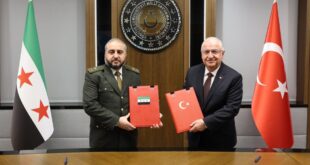BAGHDAD — Since the early days of the occupation, the United States has aimed for a democratic constitution to serve the interests of all Iraq’s ethnic and religious groups. Getting one has proven tough.
The tortured process, now approaching a climactic stage, has been marked by false starts, overblown optimism and miscalculations over the depth of suspicion and hatred in a religiously, ethnically and culturally mixed society deeply wounded by Saddam Hussein’s rule.
Time and time again, as the Americans tried to accommodate one Iraqi group, they ended up offending another.
Often, plans crafted by the White House and promoted by well-tailored emissaries in Baghdad’s hermetic Green Zone have collapsed after a few utterances by turbaned, reclusive Shiite Muslim clerics in dusty Najaf.
Then US Secretary of State Colin Powell said in September 2003 that the United States would set a deadline of six months for Iraqi leaders to produce a permanent constitution. In a sense, that deadline was met — but only with an interim charter hammered out under US pressure and after numerous policy changes forced on Washington.
When the occupation began in May 2003, the United States and its allies wanted a constitution drafted as soon as possible, in part to deflect pressure from France, Arab states and others to quickly end foreign control of Iraq.
Washington wanted UN blessing for its operation in Iraq as part of a now-abandoned US President George W. Bush administration plan to bring other countries into the reconstruction effort, share the costs and spread responsibility if things went sour.
Powell assured UN diplomats that the United States had no plans for a long-term occupation of Iraq and had a strategy to transfer power to Iraqis as soon as possible.
Central to that strategy was a new constitution. But how to draft it? Initially, the Americans wanted a panel of experts to take on the job, but had no easy formula for selecting them.
Holding an election so soon after the invasion did not seem feasible in a country with no electoral infrastructure and no accurate voter lists.
Furthermore, the United States and European Union believed they had made a mistake in the 1990s by pushing the new Balkans nations into elections so soon after conflict. The very extremists who pushed those societies into war ended up elected, since no other leaders had emerged. US officials worried Saddam’s loyalists might “hijack†Iraq’s democratic process.
As various alternatives were explored, American officials in Baghdad confidently predicted a constitutional convention could be in place by September 2003. Once a constitution was finished, elections would follow.
But in Najaf, a south-central desert city held sacred by the world’s Shiites, Grand Ayatollah Ali Sistani insisted only elected representatives should draft such a far-reaching document.
Sistani issued a binding religious decree, or fatwa, on June 28, 2003, declaring that a constitutional council chosen by Americans would be “fundamentally unacceptable.†Few of the Iraqis tapped to help administer the country wanted to cross Sistani, the most influential cleric in the Shiite majority. US overtures to Sistani not only failed to change his mind but upset the Sunni Arab minority, causing many to suspect a US plot to install Shiites as the new dominant force.
Each community was deeply suspicious of the other. Key Shiite leaders had fled to Iran and fought against their homeland in the 1980-88 war with Iraq. Thousands of Shiites were massacred by Saddam’s Sunni-dominated regime in a failed 1991 uprising.
As the constitutional process stalled, the insurgency began to catch fire in the Sunni heartland of central, western and northern Iraq.
Deciding the constitutional track was at a dead end, the White House made a major policy shift in November 2003: The Americans would convene a legislature by the following May to draft the constitution and elect a transitional government to take full sovereignty. Members of the legislature would be chosen in regional caucuses.
Sistani did not like that plan either, and ultimately it, too, was shelved.
As the Sunni insurgency worsened, though, al-Sistani agreed to accept an interim constitution drafted by US and Iraqi officials, which would be supplanted by a permanent charter written later by elected legislators.
Still, the deadline for signing the interim document was missed when the Shiites refused to show up. Sistani had reservations, among them a concession given to the Kurds that if two-thirds of the voters in three provinces rejected the permanent constitution, it would be defeated.
Kurds control three provinces.
Finally, however, Sistani gave his blessing. Later, he agreed to allow a UN envoy to name a temporary government on the promise of elections by January 30.
Those elections produced a parliament that in turn appointed a committee to draft the constitution, which was finished Sunday.
The three-province rule demanded by the Kurds could end up backfiring against them and their Shiite allies.
Sunni Arabs are a majority in at least four of Iraq’s 18 provinces, and if enough of them vote “no†in the constitutional referendum, the charter is dead.
And the whole process will have to start all over again.
 Eurasia Press & News
Eurasia Press & News



